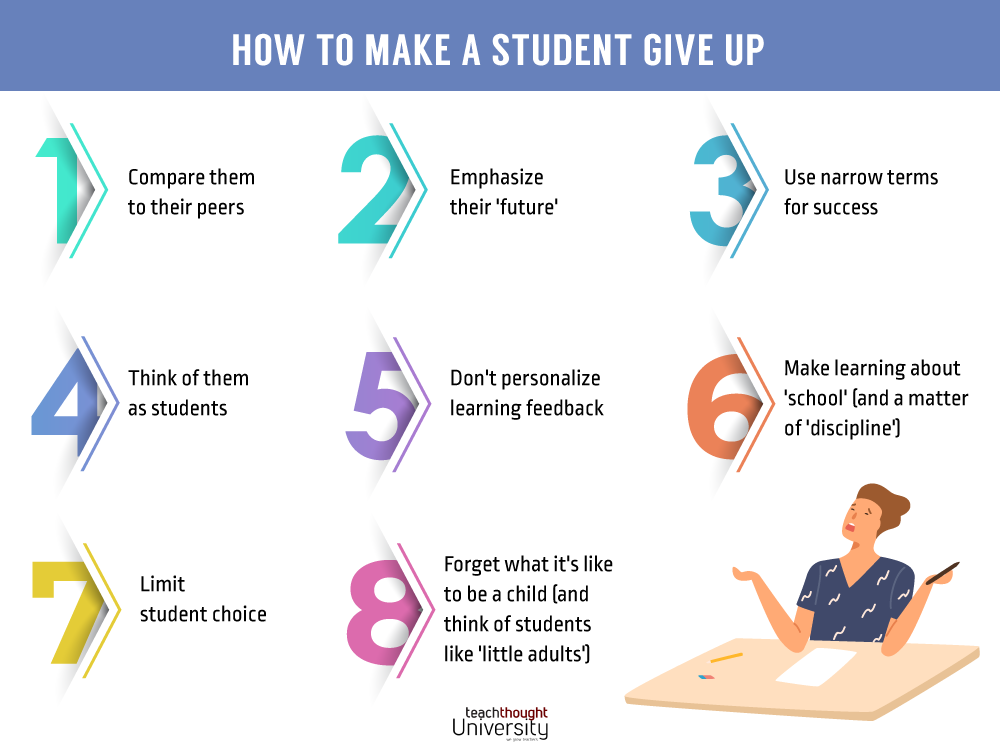
18 Ways To Make A Student Give Up
by Terry Heick
Years ago (in a post I recently updated), I talked about how to kill a student’s curiosity. I thought maybe I could follow up with some quick thoughts on how to make a student give up should that become useful for whatever reason in your classroom.
Let’s get right to it, then.
1. Compare them to their peers
Competition can be healthy, and a student seeing where they are (at that moment, anyway) relative to their peers is a natural thing. But if you really want to stifle a student’s motivation, compare them to their peers–or anyone really: brothers or sisters or parents. Anyone but the very best version of themselves.
2. Emphasize their ‘future’
Frame content as ‘preparation for their future’ instead of knowledge and meaning-making valuable to them today. Make the feedback loop as far into the future as possible for the largest effect.
3. Use narrow terms for success
Letter grades. Numbers work, too. Rubrics can be useful here too if they’re sufficiently limiting and school-centered and otherwise restrictive. Don’t use alternatives to letter grades or any creative ways of assessing understanding.
4. Give them work well beyond their Zone of Proximal Development
That is, give them work well beyond what they can do even with some support from others, much less by themselves. That should do the trick.
5. Depend on extrinsic motivation
Everyone needs a little enthusiasm or structure or discipline every now and then, but if you want to convince a student to give up, condition that student to be entirely extrinsically-motivated. The less internal motivation, the better. That way, the student is dependent on everyone around them for everything. This is a recipe for waving the white flag.
6. Don’t let them bring themselves to the work
Learning outcomes from standards and, therefore, should be standardized. Complete uniformity isn’t necessary, but quality is quality and we can’t get there if everyone’s work looks different.
If the creative student and the analytical student and the playfully defiant student and the quiet, hesitant student all ‘bring themselves’ and their natural abilities and skills to every assignment, how will we know if they’ve met the standard?
7. Focus on their weaknesses
If you want a child to give up, constantly emphasize their shortcomings and let them know you’re doing so for their own good because you were their age once and someone did it for you and you want to return the favor. Whatever you do, don’t help them see that we’re all naturally strong in some places and less strong in others.
Make sure they don’t understand that part of becoming a ‘professional’ is to narrow yourself sufficiently enough to be paid to do a very small handful of things well.
8. Deemphasize humility as crucial to learning and living
A wonderful life hack is to learn to laugh at yourself. Humility isn’t just a noble character trait but a useful way to approach living. If you want them to give up, convince them to hold themselves to impossibly high standards and take everything so seriously that they forget why they come to school every day to begin with.
And don’t forget to ‘tell on them’ every time they do ‘something bad’–to parents, to other teachers, to administrators, etc. Rules are rules, after all and you can’t be seen as condoning reckless behavior, much less contributing to it.
9. Think of them as students
If students see that you want something from them (for them to prove they’re learning) rather than to do something for them, they have a higher chance of giving up no matter how well-intentioned your reasoning is.
Be careful: If you try to get to know them as human beings and simply help guide and facilitate their cognitive growth along the way, it’s even possible for them to become inspired and you definitely don’t want that.
10. Don’t celebrate small victories
If you really want to make a student give up, set the bar high and withhold the praise until they reach it.
11. Don’t personalize learning feedback
If you want a student to give up, don’t personalize learning feedback. In fact, don’t provide effective learning feedback at all. And when you do, make it clear what they’ve done wrong and give them a letter grade or numerical score that reflects how far from the standard they still are.
Other Ways To Convince A Student To Give Up
If the above doesn’t work, there are a few other things you can try:
Limit choice. Make it your way or the highway because that’s how the ‘real world’ works.
Bring up their mistakes and failures and remind them of where they’ve fallen short.
Don’t personalize things for them–curriculum, assessment, reading assignments, skill practice, scheduling, due dates, etc., because the job of school is to prepare students for the ‘real world.’
Make the learning about ‘doing good in school’ instead of school helping you ‘do well in life.’
Make it a grind–same thing every day in the same sorts of ways to the same sorts of ends and effects.
Make progress nearly invisible and entirely decided upon by you, the teacher.
Leave the fun and emotion and laughter and affection and curiosity at home because it’s all messy and disruptive and takes too much time out of already-too-few instructional hours.
Hope this helps!
How To Make A Student Give Up